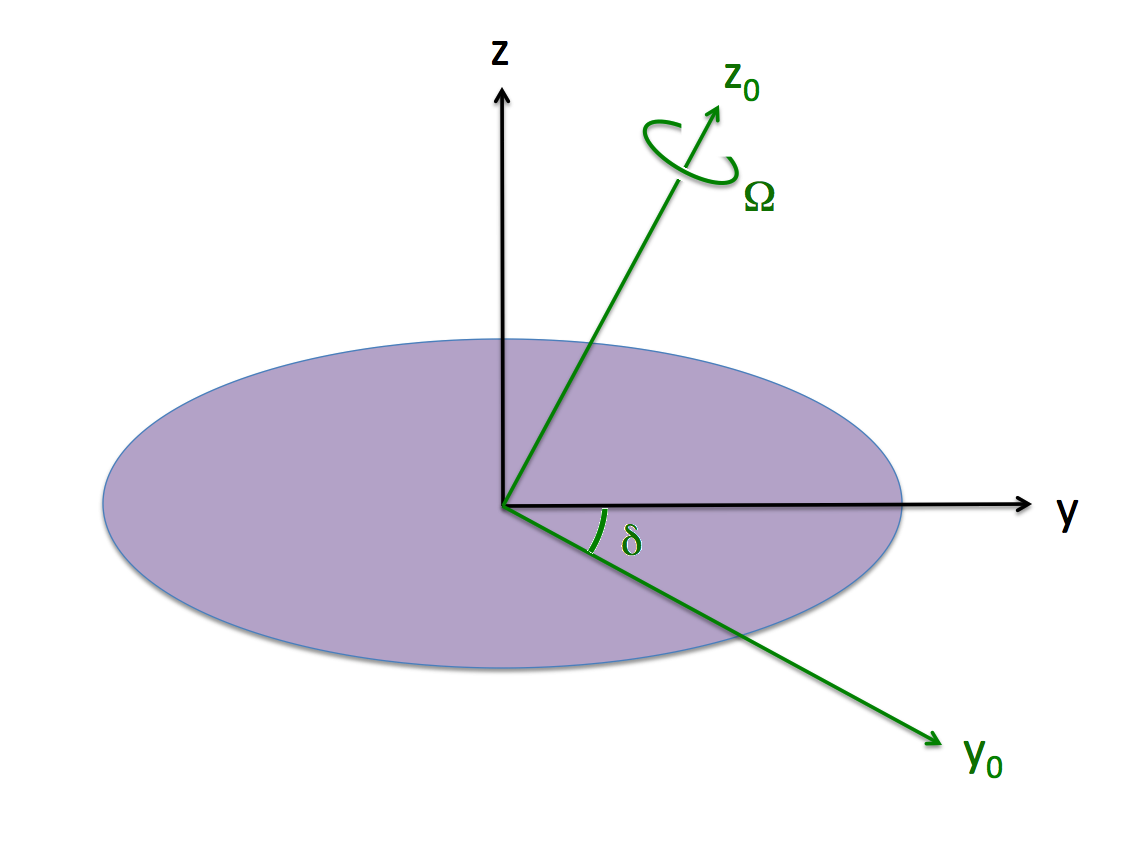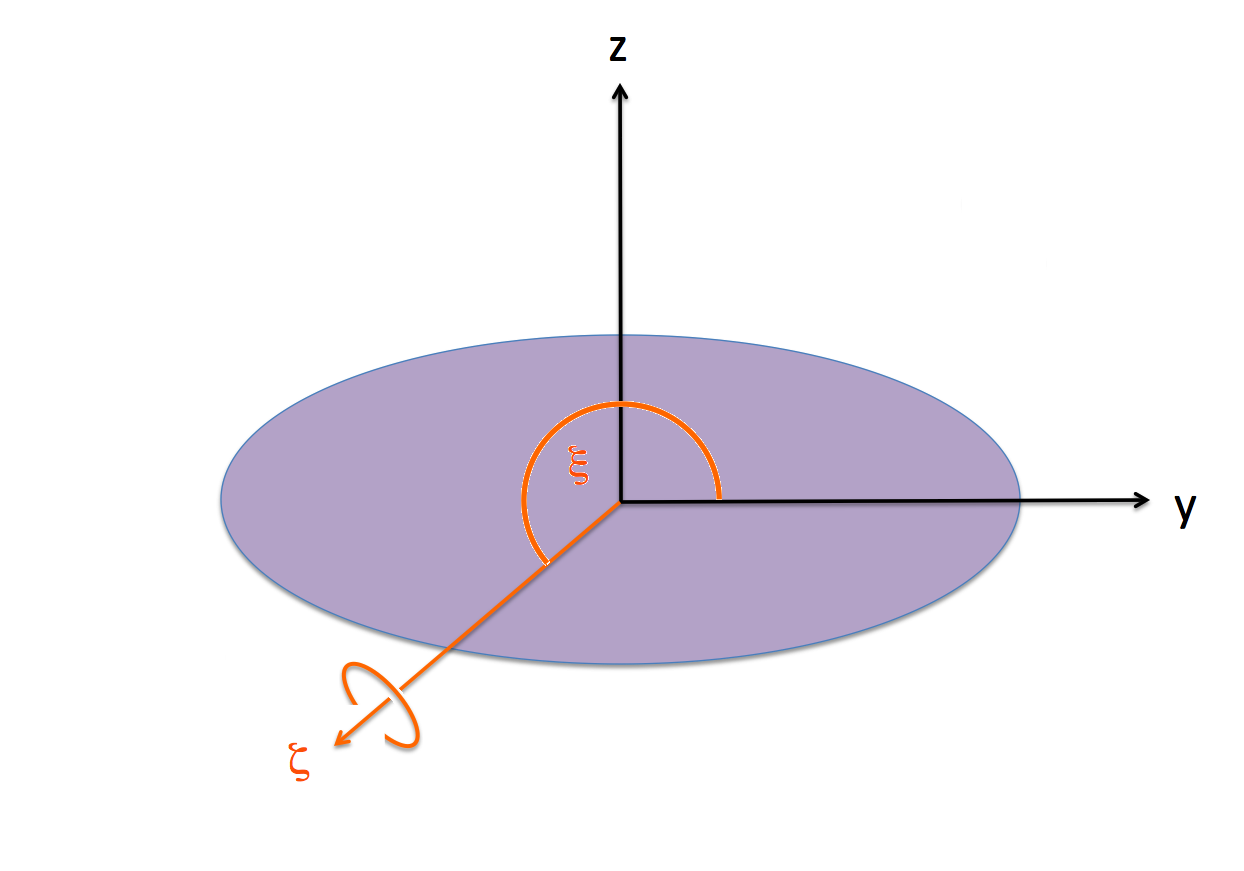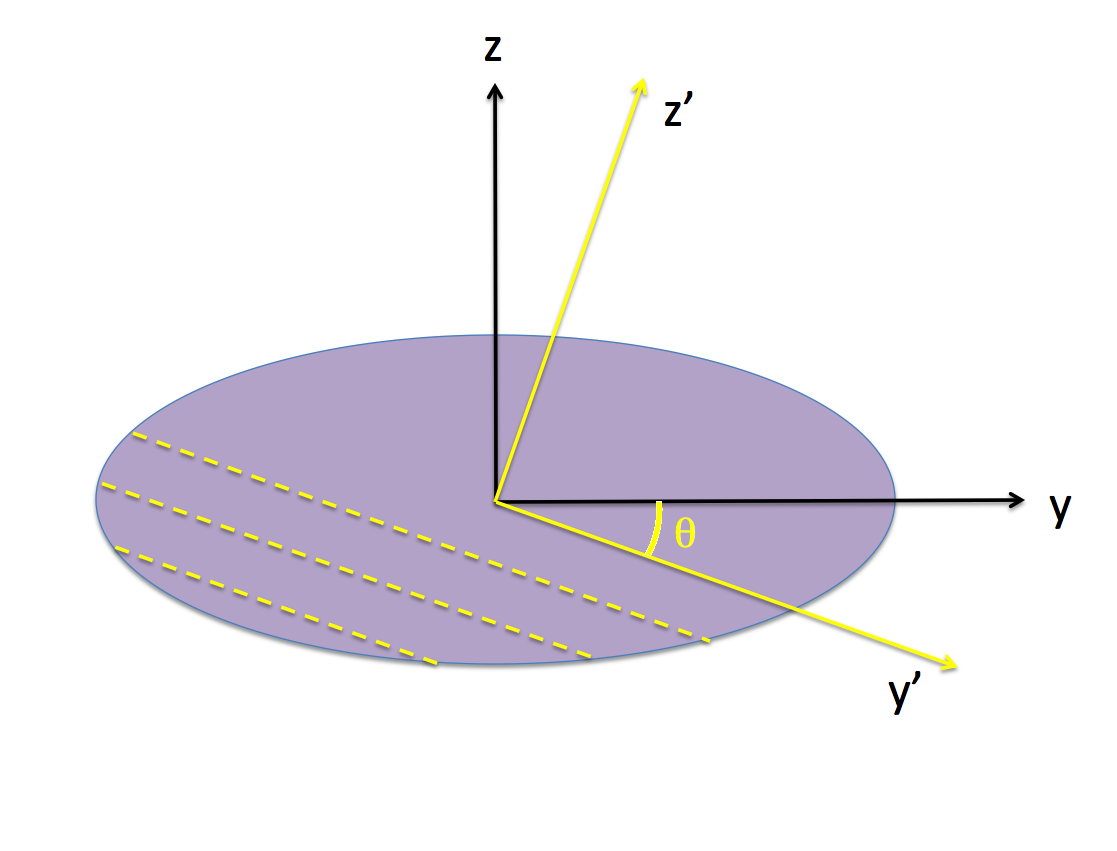Difference between revisions of "User:Tohline/ThreeDimensionalConfigurations/ChallengesPt3"
| Line 319: | Line 319: | ||
</tr> | </tr> | ||
</table> | </table> | ||
As has been summarized in an [[User:Tohline/ThreeDimensionalConfigurations/ChallengesPt2#Try_Tipped_Plane_Again|accompanying discussion]], we have determined that, | |||
<table border="0" cellpadding="10" align="right" width="30%"><tr><td align="center"> | |||
<table border="1" align="center" cellpadding="8"> | |||
<tr><td align="center"> | |||
''Tipped Orbit Frame'' (yellow, primed) <br /> | |||
</td> | |||
</tr> | |||
<tr> | |||
<td align="center">[[File:TippedAxes03.png|400px|Tipped Orbital Planes]]</td> | |||
</tr> | |||
<tr><td align="center"> | |||
Given that b/a = 1.25 and c/a = 0.4703 for our chosen [[User:Tohline/ThreeDimensionalConfigurations/ChallengesPt2#Example_Equilibrium_Model|Example Type I Ellipsoid]], we find that, <math>~\theta = - 0.3320 ~\mathrm{rad} = -19.02^\circ</math>. | |||
</td> | |||
</tr> | |||
</table> | |||
</td></tr></table> | |||
As has been summarized in an [[User:Tohline/ThreeDimensionalConfigurations/ChallengesPt2#Try_Tipped_Plane_Again|accompanying discussion]], we have determined that (numerical value given for our chosen Type I ellipsoid), | |||
<table border="0" cellpadding="5" align="center"> | <table border="0" cellpadding="5" align="center"> | ||
| Line 333: | Line 349: | ||
- \frac{\zeta_2}{\zeta_3} \biggl[ \frac{a^2 + b^2}{a^2 + c^2} \biggr] \frac{c^2}{b^2} | - \frac{\zeta_2}{\zeta_3} \biggl[ \frac{a^2 + b^2}{a^2 + c^2} \biggr] \frac{c^2}{b^2} | ||
= | = | ||
- \frac{\beta \Omega_2}{\gamma \Omega_3} \, , | - \frac{\beta \Omega_2}{\gamma \Omega_3} | ||
= | |||
-0.34479\, , | |||
</math> | </math> | ||
</td> | </td> | ||
| Line 350: | Line 368: | ||
<td align="left"> | <td align="left"> | ||
<math>~ | <math>~ | ||
\frac{a^2}{b^2 c^2} (c^2\cos^2\theta + b^2\sin^2\theta) \, , | \frac{a^2}{b^2 c^2} (c^2\cos^2\theta + b^2\sin^2\theta) = 1.05238 \, , | ||
</math> | </math> | ||
</td> | </td> | ||
| Line 365: | Line 383: | ||
<math>~ | <math>~ | ||
\zeta_3^2\biggl[ \frac{b^2}{a^2 + b^2} \biggr]^2 | \zeta_3^2\biggl[ \frac{b^2}{a^2 + b^2} \biggr]^2 | ||
\biggl[ \frac{x_\mathrm{max}}{y_\mathrm{max}} \biggr]^2 \biggl[1 + \tan^2\theta \biggr] \, , | \biggl[ \frac{x_\mathrm{max}}{y_\mathrm{max}} \biggr]^2 \biggl[1 + \tan^2\theta \biggr] = 1.68818\, , | ||
</math> | </math> | ||
</td> | </td> | ||
| Line 381: | Line 399: | ||
= | = | ||
-z' \sin\theta \cos\theta \biggl[\frac{y_\mathrm{max}}{x_\mathrm{max}} \biggr]^2 \frac{a^2}{c^2} | -z' \sin\theta \cos\theta \biggl[\frac{y_\mathrm{max}}{x_\mathrm{max}} \biggr]^2 \frac{a^2}{c^2} | ||
= | |||
z' \cos\theta (1.40038) | |||
\, .</math> | \, .</math> | ||
</td> | </td> | ||
Revision as of 21:57, 26 April 2021
Challenges Constructing Ellipsoidal-Like Configurations (Pt. 2)
This chapter extends the accompanying chapters titled, Construction Challenges (Pt. 1) and (Pt. 2). The focus here is on firming up our understanding of the relationships between various "tilted" Cartesian coordinate frames.

|
|---|
| | Tiled Menu | Tables of Content | Banner Video | Tohline Home Page | |
Various Coordinate Frames
Riemann-Derived Expressions
|
The purple (ellipsoidal) configuration is spinning with frequency, <math>~\Omega_0</math> about the <math>~z_0</math>-axis of the "inertial frame," as illustrated; that is,
|
<math>~\boldsymbol\Omega</math> |
<math>~=</math> |
<math>~\boldsymbol{\hat{k}_0}\Omega_0 \, .</math> |
Also as illustrated, the "body frame," which is attached to and aligned with the principal axes of the purple ellipsoid, is tilted at an angle, <math>~\delta</math>, with respect to the inertial frame. Hence, as viewed from the body frame, we have,
|
<math>~\boldsymbol\Omega</math> |
<math>~=</math> |
<math>~\biggl[ \boldsymbol{\hat\jmath }\sin\delta + \boldsymbol{\hat{k} }\cos\delta \biggr]\Omega_0 \, .</math> |
Now, adhering to the notation used by [EFE] — see, for example, the first paragraph of §51 (p. 156) — we should write,
|
<math>~\boldsymbol\Omega</math> |
<math>~=</math> |
<math>~\boldsymbol{\hat\jmath }\Omega_2 + \boldsymbol{\hat{k} }\Omega_3 ~~~~~\Rightarrow ~~~ \Omega_2 = \Omega_0\sin\delta </math> and, <math>~\Omega_3 = \Omega_0\cos\delta \, .</math> |
This means that,
|
<math>~\Omega_0</math> |
<math>~=</math> |
<math>~ \biggl[\Omega_2^2 + \Omega_3^2 \biggr]^{1 / 2} </math> and, <math>~\delta = \tan^{-1}\biggl[ \frac{\Omega_2}{\Omega_3} \biggr] \, .</math> |
As we have summarized in an accompanying discussion of Riemann Type 1 ellipsoids, [EFE] provides an expression for the velocity vector of each fluid element, given its instantaneous body-coordinate position (x, y, z) = (x1, x2, x3) — see his Eq. (154), Chapter 7, §51 (p. 156). As viewed from the rotating frame of reference, the three component expressions are,
|
<math>~\dot{x} = u_1 = \boldsymbol{\hat\imath} \cdot \boldsymbol{u}</math> |
<math>~=</math> |
<math>~\biggl(\frac{a}{b}\biggr)^2 \gamma \Omega_3 y - \biggl(\frac{a}{c}\biggr)^2 \beta \Omega_2 z</math> |
<math>~=</math> |
<math>~- \biggl[ \frac{a^2}{a^2 + b^2} \biggr] \zeta_3 y + \biggl[ \frac{a^2}{a^2 + c^2} \biggr] \zeta_2 z \, ,</math> |
|
<math>~\dot{y} = u_2 = \boldsymbol{\hat\jmath} \cdot \boldsymbol{u}</math> |
<math>~=</math> |
<math>~- \gamma \Omega_3 x</math> |
<math>~=</math> |
<math>~+\biggl[ \frac{b^2}{a^2 + b^2} \biggr] \zeta_3 x \, ,</math> |
|
<math>~\dot{z} = u_3 = \boldsymbol{\hat{k}} \cdot \boldsymbol{u}</math> |
<math>~=</math> |
<math>~+ \beta \Omega_2 x</math> |
<math>~=</math> |
<math>~- \biggl[ \frac{c^2}{a^2 + c^2} \biggr] \zeta_2 x \, ,</math> |
where,
|
<math>~\beta</math> |
<math>~=</math> |
<math>~ - \biggl[ \frac{c^2}{a^2 + c^2} \biggr] \frac{\zeta_2}{\Omega_2} </math> |
and, |
<math>~\gamma</math> |
<math>~=</math> |
<math>~ - \biggl[ \frac{b^2}{a^2 + b^2} \biggr] \frac{\zeta_3}{\Omega_3} \, . </math> |
|
Rotating-Frame Vorticity
|
||||||||||
For our chosen Example Type I Ellipsoid, we have, <math>~\zeta_2 = -2.2794</math> and <math>~\Omega_3 = -1.9637</math>, in which case, <math>~\zeta_\mathrm{rot} = (\zeta_2^2 + \zeta_3^2)^{1 / 2} = 2.2794</math> and <math>~\xi \equiv \tan^{-1}[\zeta_2/\zeta_3] = 4.0013 ~\mathrm{rad} = 229.26^\circ</math>. |
||||||||||
Tipped Orbit Planes
Summary
In a separate discussion, we have shown that, as viewed from a frame that "tumbles" with the (purple) body of a Type 1 Riemann ellipsoid, each Lagrangian fluid element moves along an elliptical path in a plane that is tipped by an angle <math>~\theta</math> about the x-axis of the body. As viewed from the (primed) coordinates associated with this tipped plane, by definition, z' = constant and dz'/dt = 0, and the planar orbit is defined by the expression for an,
| Off-Center Ellipse | ||
|
<math>~1</math> |
<math>~=</math> |
<math>~\biggl[\frac{x'}{x_\mathrm{max}} \biggr]^2 + \biggl[\frac{y' - y_c(z')}{y_\mathrm{max}} \biggr]^2 \, .</math> |
Notice that the offset, <math>~y_c</math>, is a function of the tipped plane's vertical coordinate, <math>~z'</math>. As a function of time, the x'-y' coordinates and associated velocity components of each Lagrangian fluid element are given by the expressions,
|
<math>~x'</math> |
<math>~=</math> |
<math>~x_\mathrm{max}\cos(\dot\varphi t)</math> |
and, |
<math>~y' - y_c</math> |
<math>~=</math> |
<math>~y_\mathrm{max}\sin(\dot\varphi t) \, ,</math> |
|
<math>~\dot{x}'</math> |
<math>~=</math> |
<math>~- x_\mathrm{max}~ \dot\varphi \cdot \sin(\dot\varphi t) = (y_c - y') \biggl[ \frac{x_\mathrm{max}}{y_\mathrm{max}} \biggr] \dot\varphi </math> |
and, |
<math>~\dot{y}' </math> |
<math>~=</math> |
<math>~y_\mathrm{max}~\dot\varphi \cdot \cos(\dot\varphi t) = x' \biggl[ \frac{y_\mathrm{max}}{x_\mathrm{max}}\biggr] \dot\varphi \, .</math> |
|
As has been summarized in an accompanying discussion, we have determined that (numerical value given for our chosen Type I ellipsoid),
|
<math>~\tan\theta</math> |
<math>~=</math> |
<math>~ - \frac{\zeta_2}{\zeta_3} \biggl[ \frac{a^2 + b^2}{a^2 + c^2} \biggr] \frac{c^2}{b^2} = - \frac{\beta \Omega_2}{\gamma \Omega_3} = -0.34479\, , </math> |
where, <math>~\beta</math> and <math>~\gamma</math> are as defined above. Also,
|
<math>~\biggl[\frac{x_\mathrm{max}}{y_\mathrm{max}} \biggr]^2</math> |
<math>~=</math> |
<math>~ \frac{a^2}{b^2 c^2} (c^2\cos^2\theta + b^2\sin^2\theta) = 1.05238 \, , </math> |
|
<math>~{\dot\varphi}^2 </math> |
<math>~=</math> |
<math>~ \zeta_3^2\biggl[ \frac{b^2}{a^2 + b^2} \biggr]^2 \biggl[ \frac{x_\mathrm{max}}{y_\mathrm{max}} \biggr]^2 \biggl[1 + \tan^2\theta \biggr] = 1.68818\, , </math> |
|
<math>~y_c</math> |
<math>~=</math> |
<math>~- \frac{z' b^2 \sin\theta\cos\theta}{c^2 \cos^2\theta + b^2\sin^2\theta} = -z' \sin\theta \cos\theta \biggl[\frac{y_\mathrm{max}}{x_\mathrm{max}} \biggr]^2 \frac{a^2}{c^2} = z' \cos\theta (1.40038) \, .</math> |
Demonstration
See Also
- Riemann Type 1 Ellipsoids
- Construction Challenges (Pt. 1)
- Construction Challenges (Pt. 2)
- Construction Challenges (Pt. 3)
- Related discussions of models viewed from a rotating reference frame:
- PGE
- NOTE to Eric Hirschmann & David Neilsen... I have moved the earlier contents of this page to a new Wiki location called Compressible Riemann Ellipsoids.

|
|---|
|
© 2014 - 2021 by Joel E. Tohline |


